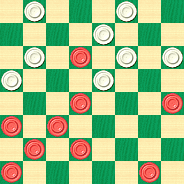Mysteries of Dama

Julius D'Orio was an interesting character. An Italian immigrant who eventually ended up in California, he was a master checkerist in the early part of the 20th century, even if a somewhat lesser player than the very best in his times. He wrote one book, Mysteries of Dama, an autographed copy of which sits on the shelves in the Checker Maven offices. Mr. D'Orio is known for his promotion of the "triangle" defense, which as a general principle of play has never been widely accepted, as it has substantial flaws (as demonstrated by Jim Loy and others).
But his book is fascinating to read, and today we present an interesting position found within it.

BLACK
Black to Play and Draw
B:W32,30,26,24,22,21,20,18:B23,15,13,12,11,8,7,4,1.
Mr. D'Orio characterizes Black's position as seemingly hopeless, and indeed, White appears to have the upper hand. Mr. D'Orio proposes a solution, which is both neat and valid. Can you find it? We asked our computer--- KingsRow with the 10-piece endgame database--- and it came back with something completely different and unexpected. Dama is indeed full of mysteries.
Don't be mystified; Mr. D'Orio's solution is within reach, even if the computer's solution might remain, well, mysterious. When you're ready, click on Read More, after which all secrets will be revealed.![]()
Solution
| 1. | 15-19! | 24x15 |
| 2. | 7-10! | 26x19 |
Mr. D'Orio here recommends instead the alternative jump, which clearly draws: 15x6 1x10 26x19 11-15 18x11 8x24 22-18 4-8 18-14 10x17 21x14 8-11 etc., to a draw. If this is the solution you found, take full credit.
However, the computer recommends 26-19, as shown above. D'Orio calls this move inferior after Black plays 10-14, and indeed White will soon face critical play; the terms of the problem effectively become "White to Play and Draw."
Why, then, does the computer choose this move? The answer is that the computer will often decide on a move which is technically better, but ignores the practical demands of over the board play. The computer may see a complex line of play that a human, given just a few minutes to make an analysis, won't find.
| 3. | 10-14 | 18x9 |
| 4. | 11x25 | 21-17 |
| 5. | 13x22 | 30x21 |
| 6. | 22-25 | 19-15 |
| 7. | 25-30 | 15-10* |
White has to get this move right. 32-28 draws, but is pointless, and 21-17, 9-5, and 32-27 all lose:
21-17 30-26 15-10 26-22 17-13 22-18 10-7 18-14 9-5 8-11 7-2 4-8 32-27 11-15 27-24 8-11 13-9 14-10 Black Wins.
9-5 8-11 15x8 4x11 21-17 11-15 17-14 30-26 14-10 26-23 10-7 15-18 7-3 23-19 3-8 19-15 32-27 18-22 27-24 22-26 8-3 26-30 3-7 15-11 7x16 12x28 Black Wins.
32-27 8-11 15x8 4x11 21-17 30-26 17-14 26-22 14-10 22-18 10-7 11-15 7-3 15-19 3-7 18-15 7-3 15-11 9-5 19-24 27-23 24-28 23-18 28-32 18-14 32-27 14-10 27-23 Black Wins.
Continuing with the main line:
| 8. | 30-26 | 9-6 |
| 9. | 26-22 | 6-2 |
| 10. | 22-18 | 10-7 |
| 11. | 18-22 | 32-27 |
| 12. | 22-18 | 7-3 |
| 13. | 18-15 | 21-17 |
| 14. | 15-18 | etc. |
Drawn. We have to say we prefer Mr. D'Orio's straightforward play to the computer's somewhat mystifying solution.
You can email the Webmaster with comments on this article.